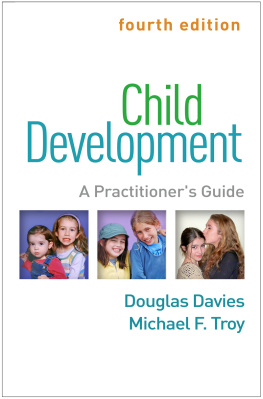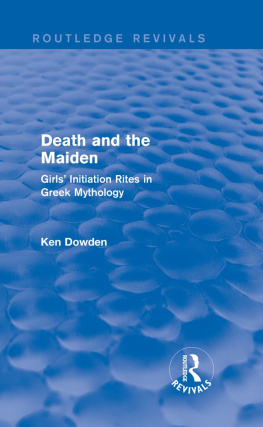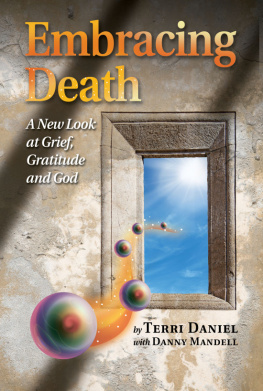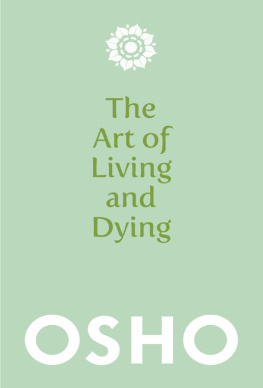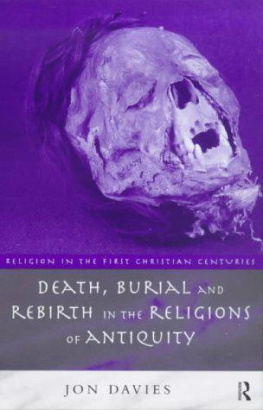Death, Ritual and Belief
Also available from Bloomsbury
Death Anxiety and Religious Belief: An Existential Psychology of Religion , Jonathan Jong and Jamin Halberstadt
The Theology of Death , Douglas Davies
Natural Burial , Douglas Davies and Hannah Rumble
Death, Ritual and Belief
The Rhetoric of Funerary RitesThird Edition
Third Edition
Douglas Davies
Bloomsbury Academic
An imprint of Bloomsbury Publishing Plc

Contents
As well as revising parts of the original text of Death, Ritual and Belief this expanded edition also includes several significant developments. Particular attention should be drawn to what I call the theory of offending deaths and to the place of death and grief in the experience of religious founders as explained in Chapter 14. The new material in Chapter 3, and Chapter 10, deal with theories of grief and the locations of death; further material has also been developed on the death of Jesus within Christianity in Chapter 8 and on near-death experience in Chapters 9 and 14. These various developments extend the essential argument of the first edition with its stress on words against death expressed through a great variety of human responses to death, whether in ritual, belief, art or architecture.
As well as revising much of the text of the second edition of Death, Ritual and Belief (2002), this third edition includes several significant developments reflecting the recent surge of interest in dying, death and memorialization across many academic and professional fields and even in social media. Innovations from my own work are included in Chapter 1 on emotional issues, Chapter 3 on grief theories, Chapter 6 on ecological burial, Chapter 14 on terrorism and Chapter 15 on spirituality, secularism and world view studies. Other inclusions from history, philosophy, theology, sociology and anthropology appear throughout this text and extend the first and second editions stress on the words against death manifest through varied human responses to death in ritual, belief, art or architecture.
Some empirical and other material in this book originated in the Rural Church Project and the Cremation in Scotland Project, both funded by the Leverhulme Trust. So too with the Cremation Research Project, funded initially by the University of Nottingham and subsequently by the Cremation Society of Great Britain and also by the Golders Green Foundation. I thank these organizations for their support in research, and the Arts and Humanities Research Council (UK) which not only funded an interdisciplinary network award focused on emotions and religious communities, but also work on natural burial through a Collaborative Doctoral Award with the Arbory Trust, which was pursued at Durham by Dr Hannah Rumble, whose work I applaud and friendship value.
Permission to reprint excerpts from Dylan Thomas, Poems of Dylan Thomas , copyright 1952 by Dylan Thomas, is given by New Directions Publishing, New York, and David Higham Associates, London. Permission to quote from Not Waving but Drowning, from the Collected Poems of Stevie Smith (Penguin Twentieth Century Classics), is given by James MacGibbon. I thank Reverend Rupert Martin and the parish of Sandal Magna for permission to use a photograph of their Tree of Life memorial, and also colleagues of Harris Manchester College, Oxford, for the photograph of the All Souls College sculpture. Thanks, too, to the publishers, especially Lalle Pursglove and colleagues, for encouragement and patience over this third edition. In retrospect, I am grateful to the Fabretti Foundation of Turin for translating the first edition of Death, Ritual and Belief and publishing it in 2000 as Riti, morte, credenze . Since the publication of the first edition I moved from Nottingham University to Durham University and thank colleagues from both for their support, so too the many generations of undergraduates on the Death module and the postgraduate students, who have made teaching, supervision and mutual learning so pleasurable.
Tree of life, St Helens Church, Sandal Magna, Leeds |
All Souls College, Oxford |
No. 1 Dad, roadside memorial, north-east England. |
Parachute Regiment, National Memorial Arboretum. |
Shot at Dawn, National Memorial Arboretum. |
Showmens Guild of Great Britain, National Memorial Arboretum. |
Marble hands, a county Durham Cemetery |
Our Darling Cat Snooky, Northumberland Park |
In Fondest Memory of Toodles Leake, Northumberland Park |
Our Loving and Faithful Pet Pat Pells, Northumberland Park |
Bambi, A beautiful lady, Northumberland Park |
Since the first and second editions of this book were published in 1997 and 2002 the interest in death has continued to increase through the media, burgeoning numbers of conferences and publications on mortality and bereavement. Alongside that growing sense of risk in daily life fostered in developed societies and captured in health and safety legislation there runs a strong counter-narrative of danger and peril engendered by acts of international and intra-national homicide, terrorism and war. Other fears lie in epidemics, whether in HIV-AIDS in some African and other contexts, or in threats of infected food supplies or global warming. Contrary to many hopes and expectations of peace and international law, warring factions and international involvement in Middle Eastern countries have led to thousands of deaths and to mass migrations of people that move with startling force across the political map of Europe.
Globalization, rooted in this media-filled world of information and fostered by a postmodern context in which time and space become condensed into immediate awareness, makes these risk factors all the more locally and keenly felt. The world has come to feel decreasingly secure, contradicting the optimism of even the first decade of the twenty-first century. Meanwhile the European Unions unified identity is far from secure with political-economic consequences of global import and with much concern over militarism and terrorism. Russian political pathways, for example, are seen by some former USSR states to be potentially intrusive, as with Georgia. Meanwhile the United States is experiencing its own internal conflicts of race, gun-crime and health-security schemes, and internal terrorism has become increasingly problematic for homeland security. Even the election of a president (elect) in late 2015 fostered its own fears of international politics. On the religious front, the rise of Russian Orthodoxy and its alignment with political leaders is remarkable when compared with the Soviet era: though less obvious, something similar is also true for Romania in Eastern Europe. Political concerns related to aspects of religious fundamentalism, not least within differing Islamic contexts, now compete with liberal engagements, with ecology and with human well-being in the broadest of senses to generate a wide spectrum of potential concern and danger.
These factors make the prime thesis of the first two editions of this book words against death more important than ever as death marks many public maps enhanced by media attention. Still, this motif underlies the human desire to live with hope for the future and captures a great deal of the material in the following chapters. Still, I stress that these chapters touch only the tips of many icebergs for much research remains to be done on every topic discussed, a continuing challenge for contemporary generations of younger scholars to engage in death studies as a profoundly important field of interdisciplinary work.


